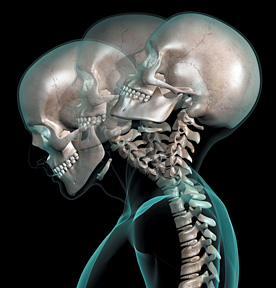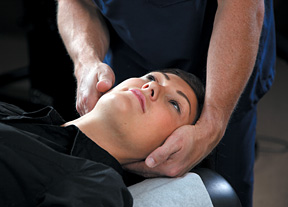Whiplash is the most common injury associated with motor vehicle accidents, affecting up to 83 percent of those involved in collisions, and is a common cause of chronic disability. The Quebec Task Force (QTF) on Whiplash Associated Disorders defines whiplash as "bony or soft tissue injuries" resulting "from rear-end or side impact, predominantly in motor vehicle accidents, and from other mishaps" as a result of "an acceleration-deceleration mechanism of energy transfer to the neck." It is estimated that as many as four per 1,000 people may experience a whiplash-related injury and associated pain syndromes. The overall economic burden of whiplash injury, including medical care, disability and sick leave, is estimated at a staggering $3.9 billion annually in the U.S. alone.
The mechanism of injury suggests that whiplash may occur as a result of hyperextension (excessive backward bending) of the lower cervical spine (neck) in relation to a hyperflexion (excessive forward bending) of the upper cervical vertebrae, producing a force of impact "whipping" through the body. The result is soft-tissue damage, inflammation and muscle spasm.
 Whiplash is associated with a wide variety of clinical symptoms including neck pain, neck stiffness, arm pain, jaw pain, headaches
and paresthesias (tingling/numbness), problems with memory and
concentration, and psychological distress. Symptoms of whiplash may not
present until several weeks after the causative incident. Frequently
people experience little pain and discomfort in the early stages.
However, after several weeks the body begins to manifest symptoms. It is
this delayed onset of symptoms and lack of early treatment intervention
which may cause the condition to become chronic and debilitating.
Whiplash is associated with a wide variety of clinical symptoms including neck pain, neck stiffness, arm pain, jaw pain, headaches
and paresthesias (tingling/numbness), problems with memory and
concentration, and psychological distress. Symptoms of whiplash may not
present until several weeks after the causative incident. Frequently
people experience little pain and discomfort in the early stages.
However, after several weeks the body begins to manifest symptoms. It is
this delayed onset of symptoms and lack of early treatment intervention
which may cause the condition to become chronic and debilitating. Whiplash Prevention
While a whiplash injury may be unavoidable if you're involved in a crash, there are simple but effective precautions you can take to minimize the risk. As they say, an ounce of prevention is worth a pound of cure.
Head restraint: If more than one person uses a car, it is better to adjust the head restraint for each driver and make sure that it's positioned according to the convenience of each driver. Not adjusting the head restraint for each driver greatly increases the likelihood of injury. The head restraint must be locked when driving. If the head restraint is not locked, it may move during an accident, taking away protective support when needed most and resulting in substantial injuries to the neck.
Evidence suggests that being the driver increases the chances of head injury by double and also shows that women suffer from whiplash injuries more than men because they tend to sit more upright and closer to the steering wheel. A study by Brian Stemper, PhD, assistant professor of neurosurgery at the Medical College of Wisconsin in Milwaukee, found: "Auto head restraints positioned less than 2.4 inches (6 cm) from the back of the head kept ligament stretch within the physiologic range - meaning that no injury would occur. However, as the restraint distance increased beyond 2.4 inches, the ligaments began to exceed failure thresholds, meaning that whiplash injury was more likely to occur."
Seat belt: Although the seat belt in and of itself will not prevent whiplash, it does help to prevent your body from lurching completely forward during a car crash, even a low-impact crash. The simple act of buckling up is responsible for approximately a 60 percent reduction in accident fatalities. So buckle up to save your life and protect your neck.
Neck exercises: Whiplash affects the neck muscles. The stronger the muscles, the less affected by sudden movement your neck will be. Engage in neck exercises to strengthen the soft tissues of the neck. Exercise won't prevent whiplash, but it can make you less susceptible to the forcible forward and backward neck jolts. Isometric resistance exercises for the neck are easy to do and highly effective in strengthening the supportive musculature of the neck. Your doctor can provide you with specific neck-strengthening exercises.
Treatment Options
Whiplash injuries are difficult to treat for many reasons. Complex interactions of psychosocial, legal and physical factors make effective treatment highly variable. However, there are many therapeutic options available to help whiplash related injuries. Initial treatment traditionally includes a soft cervical collar to restrict cervical range of motion and prevent further injury. Overall rest and motion restriction may hinder progress in the long run, so it is best to seek out professional help in resolving symptoms. That's where your chiropractor comes in.
Chiropractic: Chiropractors are the single largest group of practitioners treating whiplash injuries, and they do it well: For example, one study found chiropractors were effective at relieving whiplash pain more than 90 percent of the time. Chiropractic care focuses on relieving soft- tissue spasm, inflammation and pain by restoring proper motion in the spinal column. Due to the force impact of whiplash, the spinal column can misalign and cause pain. By performing manipulation to the spinal column, chiropractic can help restore normal function and movement to the affected areas.
 Depending on their treatment style and your specific case, your
chiropractor may decide to utilize additional treatment options in
addition to chiropractic, either in their office or via a referral. Here
are some of those potential treatments, all with the single goal of
relieving your pain and managing your whiplash symptoms in the most
effective way possible – and without requiring pain-relief medications,
which are perhaps the most common "treatment" option for whiplash
sufferers, despite the fact that they provide only short-term relief and
may create more problems than solutions in terms of the potential side
effects.
Depending on their treatment style and your specific case, your
chiropractor may decide to utilize additional treatment options in
addition to chiropractic, either in their office or via a referral. Here
are some of those potential treatments, all with the single goal of
relieving your pain and managing your whiplash symptoms in the most
effective way possible – and without requiring pain-relief medications,
which are perhaps the most common "treatment" option for whiplash
sufferers, despite the fact that they provide only short-term relief and
may create more problems than solutions in terms of the potential side
effects.Massage Therapy: Massage is one of the most effective therapies for releasing muscle tension and restoring balance to the musculoskeletal system. Massage therapy can help relax the muscles, increase and maintain range of motion, decrease stress and tension, increase circulation, and prevent and break down scar-tissue formation. Ideally, therapy should start as soon as the acute, inflammatory phase is over (about 72 hours after the injury). A massage technique called cross-fiber friction can be used to encourage the body to lay down the connective tissue in the same direction as the originally damaged tissue. This proper alignment causes smaller amounts of the connective tissue to be needed and allows for a fuller range of motion upon recovery.
Physical Therapy: Physical therapy is an effective treatment option for whiplash, especially when combined with other treatments, such as bracing. Physical therapy techniques can help restore proper function and movement of damaged tissues. Physical therapy includes both passive and active treatments. Passive treatments help relax you and your body. They're called passive because you don't have to actively participate. You'll probably start with passive treatments as your body heals and/or adjusts to the pain. But the goal of physical therapy is to get into active treatments. These are therapeutic exercises that strengthen your body so that your spine has better support.
No comments:
Post a Comment